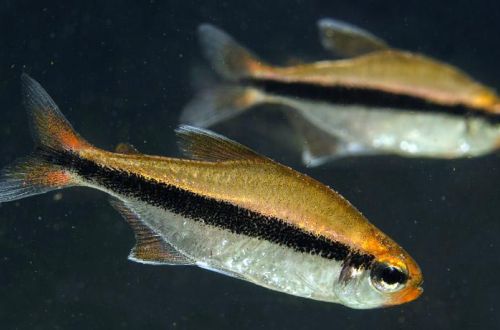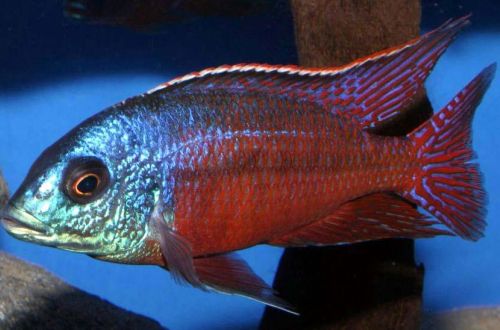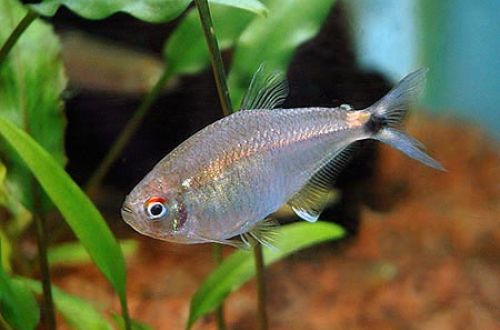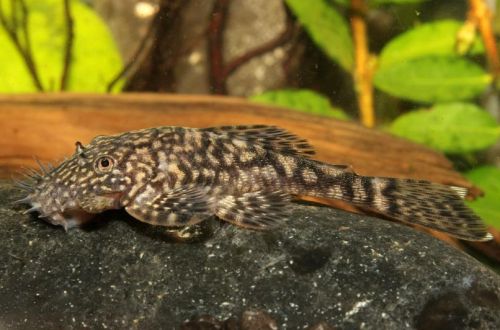
chocolate tetra
Hifessobrycon Wilma or Chocolate Neon Tetra, scientific name Hyphessobrycon vilmae, belongs to the Characidae family (Characinidae). The fish is named after Wilma Schulz, the wife of Harald Schulz (1909-1966), an ethnographer and collector of tropical fish, who first gave a scientific description of this species. Easy to keep and breed, it gets along well with other peaceful fish, which makes it an excellent choice for almost any freshwater aquarium.

Contents
Habitat
It comes from South America from the upper basin of the Tapajos River – the right tributary of the Amazon, originating in the Brazilian states of Amazonas and Mato Grosso. Inhabits small streams and rivers flowing among tropical forests. Prefers sections of rivers with sandy substrates and numerous snags.
Brief information:
- The volume of the aquarium – from 40 liters.
- Temperature – 20-26°C
- Value pH — 5.0–7.0
- Water hardness – 2–12 dGH
- Substrate type – sandy dark
- Lighting – subdued
- Brackish water – no
- Water movement is weak
- The size of the fish is about 3 cm.
- Feeding – any food of suitable size
- Temperament – peaceful
- Keeping in a group of 8-10 individuals
Description
Adult individuals reach a length of up to 3 cm. Sexual dimorphism is weakly expressed. Males and females look alike. The body pattern consists of a broad black stripe running down the middle from head to tail, separating a dark yellow back from a silvery belly. Red pigmentation may appear on the fins.
Food
Easy to feed, the home aquarium will accept most popular foods in the hobby. The daily diet may consist exclusively of dry foods in the form of flakes and granules. If possible and desired, the diet is diluted with live or frozen brine shrimp, daphnia, etc.
Maintenance and care, arrangement of the aquarium
The optimal size of the aquarium for a flock of 8-10 fish starts from 40 liters. The choice of design is not critical and is selected based on the preferences of the aquarist. However, Hifessobrikon Wilma looks more harmonious in an environment reminiscent of its natural habitat – in subdued light among thickets of aquatic plants and snags.
An additional design element will be the dry foxes of some trees, which are placed at the bottom. As in the river, fallen leaves decompose, releasing tannins, giving the water a chemical composition similar in composition to water from natural reservoirs where these fish are found. In addition, the leaves serve as the basis for the development of a colony of microorganisms, such as the ciliate slipper, a valuable secondary food source for fry.
Successful long-term maintenance depends on several factors, the most important of which is water quality. Fish need stable water conditions, it is worth avoiding sharp fluctuations in the values of hydrochemical parameters and temperatures, as well as reaching dangerous concentrations of nitrogen cycle products (ammonia, nitrites, nitrates). The balance of the aquarium ecosystem determines the level of its equipment with all the necessary equipment, primarily a filtration system, as well as the regularity of maintenance. The latter include the weekly replacement of part of the water with fresh water, checking it for compliance with the basic parameters, timely removal of organic waste (feed leftovers, excrement), replacing leaves, if any, etc.
Behavior and Compatibility
Peaceful schooling fish, it is desirable to keep in a group of at least 8-10 individuals. With a smaller number, it can become overly shy, especially in the vicinity of large species. Compatible with other freshwater non-aggressive fish of comparable size.
Breeding / breeding
The breeding strategy of the Chocolate Tetra is typical of most characins. During the spawning period, females scatter eggs among plants or directly on open ground, and males fertilize them. There is no clearly defined breeding season; different fish can give birth at different times. Parental instincts are not developed, so there is no care for offspring. If you plan to keep the brood, then the fertilized eggs should be placed in a separate tank with identical water conditions to the main aquarium. Otherwise, most likely the caviar will be eaten.
Fish diseases
Diseases inherent in this particular species of fish were not noted. When kept in suitable conditions (high water quality, balanced diet, non-conflict neighbors, etc.), health problems are not observed. The most common cause of disease is the deterioration of conditions leading to immune suppression, which makes the fish susceptible to infections that are invariably present in the surrounding area. When the first signs of an illness are detected (lethargy, exhaustion, refusal of food, lowered fins, etc.), it is necessary to immediately check the main parameters of the water. Often, the restoration of acceptable living conditions contributes to self-healing, but if the fish is too weak or has received obvious damage, medical treatment will be required. For more information on symptoms and treatments, see the Aquarium Fish Diseases section.





